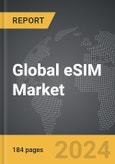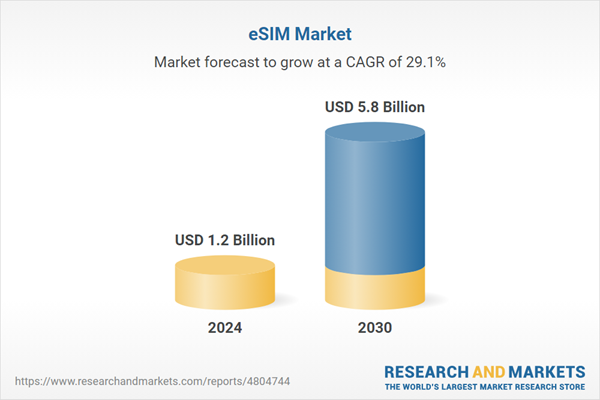The global market for eSIM was valued at US$1.2 Billion in 2024 and is projected to reach US$5.8 Billion by 2030, growing at a CAGR of 29.1% from 2024 to 2030. This comprehensive report provides an in-depth analysis of market trends, drivers, and forecasts, helping you make informed business decisions. The report includes the most recent global tariff developments and how they impact the eSIM market.
Technological advancements have played a crucial role in the development and deployment of eSIMs. The standardization of eSIM technology by the GSMA has facilitated widespread adoption and interoperability across different devices and network operators. Advanced security features, such as remote SIM provisioning and secure element integration, ensure that eSIMs provide robust protection against unauthorized access and cyber threats. Furthermore, the miniaturization of electronic components has enabled the incorporation of eSIMs into compact devices, supporting the growth of wearables and other small IoT devices. eSIM technology also supports multiple profiles, allowing users to have separate profiles for personal and business use or for different regions, further enhancing its versatility and appeal.
The growth in the eSIM market is driven by several factors. The increasing adoption of IoT devices, which require reliable and flexible connectivity solutions, is a significant driver, as eSIMs offer an ideal solution for managing multiple devices efficiently. The growing demand for connected cars and smart city applications is also propelling the market, as eSIMs enable seamless connectivity and management for a multitude of devices and sensors. Technological advancements in mobile devices and network infrastructure are making eSIMs more accessible and practical, encouraging their integration into a broader range of products. Additionally, the rising consumer demand for flexible and convenient connectivity options, combined with the benefits of streamlined logistics and reduced environmental impact from eliminating physical SIM cards, is further boosting the market. Together, these factors are fostering a dynamic and expanding market for eSIM technology, presenting significant opportunities for innovation and growth in the telecommunications industry.
Segments: Application (M2M, Smartphones, Connected Cars, Laptops & Tablets, Wearables, Other Applications).
Geographic Regions/Countries: World; USA; Canada; Japan; China; Europe; France; Germany; Italy; UK; Rest of Europe; Asia-Pacific; Rest of World.
The analysts continuously track trade developments worldwide, drawing insights from leading global economists and over 200 industry and policy institutions, including think tanks, trade organizations, and national economic advisory bodies. This intelligence is integrated into forecasting models to provide timely, data-driven analysis of emerging risks and opportunities.
Global eSIM Market - Key Trends & Drivers Summarized
eSIM, or embedded SIM, represents a significant evolution in SIM card technology, offering a new level of flexibility and convenience for mobile connectivity. Unlike traditional SIM cards, which are physical cards inserted into a device, eSIMs are embedded directly into the device's hardware during manufacturing. This integration allows for remote provisioning and management of mobile network profiles, eliminating the need for physical SIM swaps. Users can switch between different network operators or plans seamlessly through software settings, making eSIMs particularly advantageous for travelers, businesses, and IoT applications. The adoption of eSIM technology is rapidly growing in smartphones, tablets, smartwatches, and other connected devices, driven by its ability to simplify connectivity and enhance user experience.Technological advancements have played a crucial role in the development and deployment of eSIMs. The standardization of eSIM technology by the GSMA has facilitated widespread adoption and interoperability across different devices and network operators. Advanced security features, such as remote SIM provisioning and secure element integration, ensure that eSIMs provide robust protection against unauthorized access and cyber threats. Furthermore, the miniaturization of electronic components has enabled the incorporation of eSIMs into compact devices, supporting the growth of wearables and other small IoT devices. eSIM technology also supports multiple profiles, allowing users to have separate profiles for personal and business use or for different regions, further enhancing its versatility and appeal.
The growth in the eSIM market is driven by several factors. The increasing adoption of IoT devices, which require reliable and flexible connectivity solutions, is a significant driver, as eSIMs offer an ideal solution for managing multiple devices efficiently. The growing demand for connected cars and smart city applications is also propelling the market, as eSIMs enable seamless connectivity and management for a multitude of devices and sensors. Technological advancements in mobile devices and network infrastructure are making eSIMs more accessible and practical, encouraging their integration into a broader range of products. Additionally, the rising consumer demand for flexible and convenient connectivity options, combined with the benefits of streamlined logistics and reduced environmental impact from eliminating physical SIM cards, is further boosting the market. Together, these factors are fostering a dynamic and expanding market for eSIM technology, presenting significant opportunities for innovation and growth in the telecommunications industry.
Report Scope
The report analyzes the eSIM market, presented in terms of units. The analysis covers the key segments and geographic regions outlined below.Segments: Application (M2M, Smartphones, Connected Cars, Laptops & Tablets, Wearables, Other Applications).
Geographic Regions/Countries: World; USA; Canada; Japan; China; Europe; France; Germany; Italy; UK; Rest of Europe; Asia-Pacific; Rest of World.
Key Insights:
- Market Growth: Understand the significant growth trajectory of the M2M segment, which is expected to reach US$1.8 Billion by 2030 with a CAGR of a 28.3%. The Smartphones segment is also set to grow at 31.7% CAGR over the analysis period.
- Regional Analysis: Gain insights into the U.S. market, valued at $360.9 Million in 2024, and China, forecasted to grow at an impressive 32.9% CAGR to reach $445.0 Million by 2030. Discover growth trends in other key regions, including Japan, Canada, Germany, and the Asia-Pacific.
Why You Should Buy This Report:
- Detailed Market Analysis: Access a thorough analysis of the Global eSIM Market, covering all major geographic regions and market segments.
- Competitive Insights: Get an overview of the competitive landscape, including the market presence of major players across different geographies.
- Future Trends and Drivers: Understand the key trends and drivers shaping the future of the Global eSIM Market.
- Actionable Insights: Benefit from actionable insights that can help you identify new revenue opportunities and make strategic business decisions.
Key Questions Answered:
- How is the Global eSIM Market expected to evolve by 2030?
- What are the main drivers and restraints affecting the market?
- Which market segments will grow the most over the forecast period?
- How will market shares for different regions and segments change by 2030?
- Who are the leading players in the market, and what are their prospects?
Report Features:
- Comprehensive Market Data: Independent analysis of annual sales and market forecasts in US$ Million from 2024 to 2030.
- In-Depth Regional Analysis: Detailed insights into key markets, including the U.S., China, Japan, Canada, Europe, Asia-Pacific, Latin America, Middle East, and Africa.
- Company Profiles: Coverage of players such as Samsung Group, NXP Semiconductors NV, NTT Docomo, Inc., Singapore Telecommunications Ltd. (SingTel), Sierra Wireless, Inc. and more.
- Complimentary Updates: Receive free report updates for one year to keep you informed of the latest market developments.
Some of the 38 companies featured in this eSIM market report include:
- Samsung Group
- NXP Semiconductors NV
- NTT Docomo, Inc.
- Singapore Telecommunications Ltd. (SingTel)
- Sierra Wireless, Inc.
- Telenor ASA
- Telenor Connexion
- Telit IoT Platforms, LLC
- Truphone Limited
- 1oT
- GotYu
- Airalo
- Otono Networks
- Gigs Inc
- Monty Holding Group (Monty Mobile)
Tariff Impact Analysis: Key Insights for 2025
Global tariff negotiations across 180+ countries are reshaping supply chains, costs, and competitiveness. This report reflects the latest developments as of April 2025 and incorporates forward-looking insights into the market outlook.The analysts continuously track trade developments worldwide, drawing insights from leading global economists and over 200 industry and policy institutions, including think tanks, trade organizations, and national economic advisory bodies. This intelligence is integrated into forecasting models to provide timely, data-driven analysis of emerging risks and opportunities.
What’s Included in This Edition:
- Tariff-adjusted market forecasts by region and segment
- Analysis of cost and supply chain implications by sourcing and trade exposure
- Strategic insights into geographic shifts
Buyers receive a free July 2025 update with:
- Finalized tariff impacts and new trade agreement effects
- Updated projections reflecting global sourcing and cost shifts
- Expanded country-specific coverage across the industry
Table of Contents
I. METHODOLOGYMII. EXECUTIVE SUMMARY2. FOCUS ON SELECT PLAYERSIII. MARKET ANALYSISIV. COMPETITION
1. MARKET OVERVIEW
3. MARKET TRENDS & DRIVERS
4. GLOBAL MARKET PERSPECTIVE
UNITED STATES
CANADA
JAPAN
CHINA
EUROPE
FRANCE
GERMANY
ITALY
UNITED KINGDOM
REST OF EUROPE
ASIA-PACIFIC
REST OF WORLD
Companies Mentioned (Partial List)
A selection of companies mentioned in this report includes, but is not limited to:
- Samsung Group
- NXP Semiconductors NV
- NTT Docomo, Inc.
- Singapore Telecommunications Ltd. (SingTel)
- Sierra Wireless, Inc.
- Telenor ASA
- Telenor Connexion
- Telit IoT Platforms, LLC
- Truphone Limited
- 1oT
- GotYu
- Airalo
- Otono Networks
- Gigs Inc
- Monty Holding Group (Monty Mobile)
Table Information
| Report Attribute | Details |
|---|---|
| No. of Pages | 184 |
| Published | April 2025 |
| Forecast Period | 2024 - 2030 |
| Estimated Market Value ( USD | $ 1.2 Billion |
| Forecasted Market Value ( USD | $ 5.8 Billion |
| Compound Annual Growth Rate | 29.1% |
| Regions Covered | Global |









